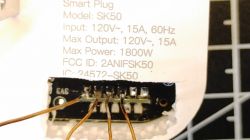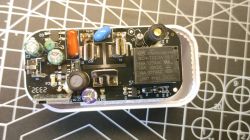Hi all, I'm going to apologize in advance because I'm a novice at best and am not strong in python or programming. I'm able to follow people's directions and have had great luck flashing openbeken and Tasmota to many devices, as well as successfully desoldering and installing new modules where previous non-compatible modules exited.
I'm trying to flash openbeken to multiple TreatLife Smart Plugs (US variant). A lot more detail about this device can be found on the FCC Listing, specifically the internal photos.
I've flashed twelve already, but the old ones have WB3S modules in them, and these new ones have WB2S.

I've soldered connections directly to the 3V, GND, TX, and RX on the WB2S module and am using a DSD TECH SH-U09C2 to connect between my laptop (Windows 11) and the module. I was always able to flash them with UART using the command:

Because the WB3S and WB2S are very similar I tried flashing them the same way, however it would fail with an error stating "Unprotect Failed." I removed the "--unprotect" command. This would successfully flash, however the openbeken WiFi AP never became available, and when reconnecting the serial adapter, the RXD LED would flash rapidly without stopping. I could reflash again by shorting GND to CEN again to gain bus, but always ending in the same result.
I then tried flashing again using the following command:
This would flash, but return "Read CRC Failed." The openbeken AP was again not available, however on attempting to reflash, shorting GND to CEN does not work to get bus. I came across a thread here that said to leave off the "--startaddr 0x0" command for BK7321T modules, maybe that's my problem? Thus far, nothing has worked on any device flashed with that last command.
Have I bricked the WB2S modules that I've tried to flash? Are there any recovery options? I've been scouring this forum and the internet for a while, but I'm at a loss.



I'm trying to flash openbeken to multiple TreatLife Smart Plugs (US variant). A lot more detail about this device can be found on the FCC Listing, specifically the internal photos.
I've flashed twelve already, but the old ones have WB3S modules in them, and these new ones have WB2S.

I've soldered connections directly to the 3V, GND, TX, and RX on the WB2S module and am using a DSD TECH SH-U09C2 to connect between my laptop (Windows 11) and the module. I was always able to flash them with UART using the command:
python uartprogram C:\Users\UserName\Downloads\Tech\IoT\OpenBeken\OpenBK7231T_QIO_1.17.308.bin --unprotect -d com3 -w --startaddr 0x0 
Because the WB3S and WB2S are very similar I tried flashing them the same way, however it would fail with an error stating "Unprotect Failed." I removed the "--unprotect" command. This would successfully flash, however the openbeken WiFi AP never became available, and when reconnecting the serial adapter, the RXD LED would flash rapidly without stopping. I could reflash again by shorting GND to CEN again to gain bus, but always ending in the same result.
I then tried flashing again using the following command:
c:\Windows\System32>python uartprogram C:\Users\TheBo\Downloads\Tech\IoT\OpenBeken\OpenBK7231T_QIO_1.17.308.bin -d com3 -w --startaddr 0x0This would flash, but return "Read CRC Failed." The openbeken AP was again not available, however on attempting to reflash, shorting GND to CEN does not work to get bus. I came across a thread here that said to leave off the "--startaddr 0x0" command for BK7321T modules, maybe that's my problem? Thus far, nothing has worked on any device flashed with that last command.
Have I bricked the WB2S modules that I've tried to flash? Are there any recovery options? I've been scouring this forum and the internet for a while, but I'm at a loss.









